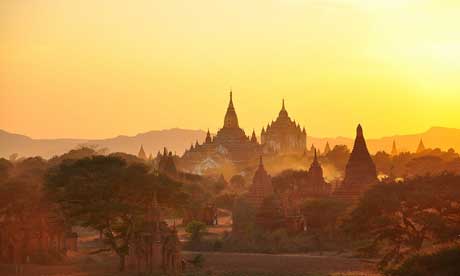
Regarded as ‘the world's most remarkable religious city’ – today, this extraordinary lost capital seems all but deserted, finds Rory MacLean
The dusk is filled with the tinkle of temple bells, countless tiny chimes stirred by the evening breeze. Around 2,000 monumental stupas dot the dusty plain.
According to the Victorian traveller James Scott, ‘Jerusalem, Rome, Kiev, Benares, none of these can boast the multitude of temples, and lavishness of design and ornament’ to be found in Pagan. In his day it was ‘the most remarkable religious city in the world’. Today, this extraordinary lost capital seems all but deserted.
From the upper terrace of soaring Thatbyinnyu Temple, 60m above the ground, it’s possible to conjure up the ancient city bustling 800 years ago: the smell of cooking rising with the murmur of voices; the wind carrying the chants of meditating monks; villagers bathing in the Irrawaddy; trading barques from Ceylon and Siam swaying in the swells; and, as night falls beyond the river’s great arc, 10,000 lamps flickering.
On my last visit to Pagan I asked a young horse cart driver what had happened to the old village. “Kublai Khan destroy,” he told me.
“No, not the city,” I said. The Mongols had sacked ancient Pagan in 1287. “Twenty years ago when I first came here, there was a small village.”
The driver turned to stare at me and I thought for a moment that he hadn’t understood. Then he replied carefully, “No village, no sir.” He fidgeted with the reigns. “A few farmers, maybe, but no village.” The cart turned off the track. “Today is my first day as horse cart driver,” the driver whispered to me.
“I wish you success.”
“I must have success,” he hissed. “Many tourists must come to Pagan so I may be permitted to feed my family.” He took a breath. “That is why it is important not to talk about many things in Burma.”
The Burmese regime has selected the site of Pagan – along with Rangoon and Mandalay – as key tourist destinations. A frenzy of hotel building has razed old neighbourhoods and transformed city centres. In the Rangoon one million civilians have been expelled.
Since my first visit, Pagan’s 5,200 residents, many of whom had lived beside the ancient temples for generations, had been relocated. Compensation of 250 kyats – about $2 at the time – was paid per home. Bulldozers then flattened the old village.
Aung San Suu Kyi, leader of the National League for Democracy, has asked tourists not to come to her country until it is again a democratic nation. Those of us able to travel, who choose to visit Burma while it remains under the rule of the junta, must go there with the express intention of bearing witness to the tragedy and suffering of the betrayed, golden land.
Rory MacLean, travel writer and author of Under the Dragon: A Journey Through Burma (Tauris Parke, 2008)